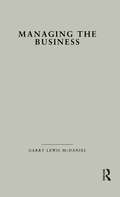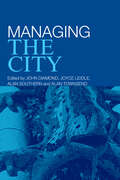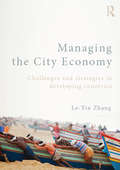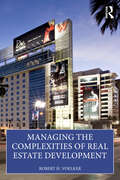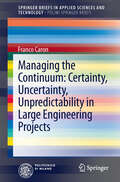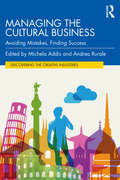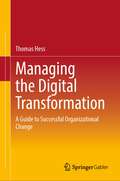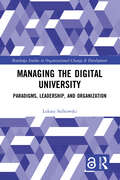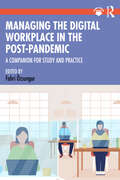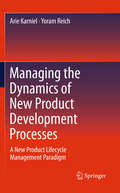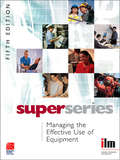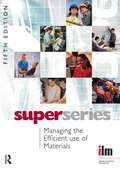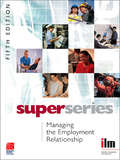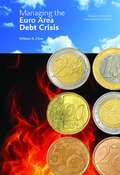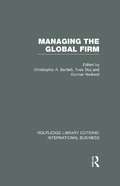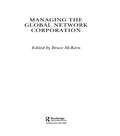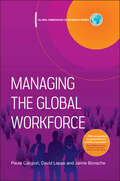- Table View
- List View
Managing the Business: How Successful Managers Align Management Systems with Business Strategy (Studies on Industrial Productivity: Selected Works)
by Garry L. McDanielFirst published in 2000. Managers who are able to conceptualize and align management systems with business strategy are more likely to achieve on-the-job results, receive higher performance appraisals, and move up in the organization. This in-depth study of senior, middle and first-line managers examines how successful managers use management systems to achieve high productivity and innovation in their areas of responsibility. In today's fast-paced, dynamic and highly competitive work environment, organizations strive to attract and develop strong leaders and managers. Executive, human resource specialists, organization development and training professionals are vitally interested in learning what qualities or characteristics the best leaders and managers exhibit, and how to develop those qualities in their existing workforce. While previous research has focused on the qualities of strong leader/managers primarily in senior or first-line management positions, this book reports the results of a comprehensive analysis of successful senior, middle and first-line managers in a high technology company. In this book, the reader will learn how the best managers define management systems and align those systems with business strategy in ways that achieve desired business results, and identify them as the leaders of the future.
Managing the City
by John Diamond Alan Townsend Joyce Liddle Alan SouthernTaking a problem based approach to regeneration management, this exciting new book, authored by renowned academics and practitioners, examines how issues of ethics, equality, sustainability, local governance, civic renewal and learning are addressed within the areas of social and economic development and transformation. The issues covered here have significant implications for the ways in which regeneration initiatives are put together (in their design, development and delivery), as well as for the skills and learning needs of practitioners and the ways in which initiatives are then managed and led. This informative book provides the tools and techniques, using a mixture of rigorous academic theory and practical insights, to enable any reader to gain insight into this important subject. Drawing upon a breadth of experience both in practice and in academia, the contributors present the gaps and challenges within regeneration management, and the editors provide a framework within which the practical difficulties facing those engaged in the process of regeneration can be managed. Engaging and comprehensive, this book is an invaluable resource for all those involved in regeneration.
Managing the City Economy: Challenges and Strategies in Developing Countries
by Le-Yin ZhangIn a world increasingly organised as networks of cities, this book offers the first full-length treatment of the subject of managing the city economy. It explores key challenges and strategies, particularly in developing countries, where developmental deficits are greatest and almost all urban growth up to 2050 will take place. Adopting a practitioner’s perspective, theoretically grounded and international in scope, this book is unique in its focus and endeavours to connect theory with practice. Through an interdisciplinary and strategic approach, this book explores the challenges and options in managing the contemporary city economy. It aims to illustrate the extent to which appropriate policy interventions in the city economy could offer effective solutions to some of the most difficult social and environmental challenges facing cities. The book comprises five main parts. Part I sets the scene and examines contemporary processes that affect cities and explains the challenges they pose for city managers. Part II presents a selection of conceptual frameworks commonly used in urban economic analysis. Part III examines the management of sectoral growth, covering manufacturing, exports of services, transport and logistics, and real estate. Part IV addresses urban poverty, low-carbon transition and the informal economy. Part V focuses on laying the foundation for long-term city development, exploring the roles of city development strategies, municipal finance, investment in people and appropriate infrastructure. This book is designed for graduate courses in urban economic development, urban planning, urban policy and public administration, and for professionals who are involved in the management of city economies or/and conducting research, consultancy or policy advocacy for cities. Through critical review of relevant debates and a dozen case studies this book will equip city managers with the knowledge required to strengthen the performance of their city economy while delivering authentic and sustainable development.
Managing the Client Portfolio
by Nitin Nohria Ashish NandaThe German country managing partner of a global law firm must decide how to respond to a corporate mandate to restructure its client portfolio. The case enables a discussion of different types of clients in a global professional service firm in terms of relative revenues, profitability, and strategic significance. It also highlights the tensions between local subsidiaries and corporate headquarters with respect to managing client portfolios.
Managing the Complexities of Real Estate Development
by Bob VoelkerManaging the Complexities of Real Estate Development provides a concise summary of the real estate development process, allowing the reader to learn the fundamentals and details of development outside of the sink-or-swim environment of a particular project. It offers early and mid-career real estate, legal, and financial professionals a behind the scenes view of the dynamic real estate development world, including: how developers make money, how development companies are structured, site location and acquisition, financial analysis, the design and development process, securing financing, project performance evaluation, and project sale or refinance. While focusing on multifamily apartment developments, the idiosyncrasies of retail, office, hotels, and mixed-use projects are also covered.
Managing the Continuum: Certainty, Uncertainty, Unpredictability in Large Engineering Projects
by Franco CaronThe brief will describe how to develop a risk analysis applied to a project , through a sequence of steps: risk management planning, risk identification, risk classification, risk assessment, risk quantification, risk response planning, risk monitoring and control, process close out and lessons learning. The project risk analysis and management process will be applied to large engineering projects, in particular related to the oil and gas industry. The brief will address the overall range of possible events affecting the project moving from certainty (project issues) through uncertainty (project risks) to unpredictability (unforeseeable events), considering both negative and positive events. Some quantitative techniques (simulation, event tree, Bayesian inference, etc.) will be used to develop risk quantification. The brief addresses a typical subject in the area of project management, with reference to large engineering projects concerning the realization of large plants and infrastructures. These projects are characterized by a high level of change, uncertainty, complexity and ambiguity. The brief represents an extension of the material developed for the course Project Risk Analysis and Management of the Master in Strategic Project Management (Erasmus Mundus) developed jointly by Politecnico di Milano, Heriot Watt University (Edimburgh) and Umea (Sweden). The brief may be used both in courses addressing project management subjects and by practitioners as a guide for developing an effective project risk management plan.
Managing the Crisis You Tried to Prevent
by Norman R. AugustineNew reports announcing that yet another business has stumbled into a crisis--often without warning and through no direct fault of its management--seem as regular as the tide. And the spectrum of business crises is so wide that it is impossible to list each type. On a single day this year, the Washington Post reported a series of crashes suffered by American Eagle Airlines, the bankruptcy of Orange County, and Intel's travails with its Pentium microprocessor. Fortunately, almost every crisis contains within itself the seeds of success as well as the roots of failure. Finding, cultivating, and harvesting that potential success is the essence of crisis management.
Managing the Cultural Business: Avoiding Mistakes, Finding Success (Discovering the Creative Industries)
by Michela Addis Andrea RuraleThe arts and cultural sector has always been a challenging area in which to find business success; the advent of the global health crisis due to COVID-19 has greatly amplified these challenges. Thanks to the expertise of 22 scholars, this text elaborates on the most common key strategic mistakes and misunderstandings to help arts and cultural organizations finding success. This book starts by looking at the evolution of competition in those industries. Several new and challenging drivers shape the competitive environments of arts and cultural organizations. A customer-centric approach helps in identifying ten crucial managerial processes in which strategic mistakes are commonly made. This book proposes a revised managerial vision of the key processes that constitute every arts and cultural organization. Each chapter offers an innovative analysis of a classic managerial problem, describing popular mistakes and providing case-based insights derived from real world important examples. Specifically, each chapter elaborates on two illuminating examples, one of which is always chosen among the Italian arts and cultural organizations, thus belonging to the world’s leading cultural sector. Speaking to current and student arts managers, this insightful book channels national and supranational cultural heritage to provide essential reading for managers of present and future arts and cultural organizations.
Managing the Digital Transformation: A Guide to Successful Organizational Change
by Thomas HessDigitisation and digital transformation are not only a topic of the media, but are also taking place in companies. The digital transformation affects the most diverse fields, from procurement to sales and from organisation to strategy development. This task requires the commitment of every company management and cannot simply be delegated. This book aims to help managers and entrepreneurs to set up structures in their organisation that allow them to approach the digital transformation systematically. The topics covered range from the configuration of digitisation strategies and new management roles such as the Chief Digital Officer to the importance of IT infrastructures, HR management and corporate culture as enablers of digital transformation. A simple framework serves as an orientation framework that structures the management tasks and clearly summarises the various concepts and instruments.In the 2nd revised and expanded edition, the focus is on organisational aspects, in particular the role of start-ups for the digital transformation, the design of the so-called Digital Innovation Units and the role of the CDO. Secondly, the design and management of digitisation projects is considered in more detail. And thirdly, the concept of digital transformation is further specified and delimited. In addition, the advancing technological development is taken into account."Prof. Thomas Hess provides a concrete overview of many important aspects to be considered in the digital transformation of companies. Clearly worth reading."Stefan Winners, Chief Digital Officer at Hubert Burda Media"Beyond the buzzword - Finally someone manages to systematically untangle the chaos surrounding digital transformation. With his book, Thomas Hess truly establishes the guardrails for managing digital transformation projects. While others promise much and deliver little, Thomas Hess gives the reader a design framework rather than a patent remedy."Dr Christoph Steiger, former board member and CDO of Hoffmann Group"Clearly more than just another book on the topic of digital transformation! With exciting insights from science and practice, Thomas Hess provides a toolbox for digital transformation. Relevant for business and relevant researchers."Prof. em. Dr. Dr. h.c. Hubert Österle, University of St. Gallen
Managing the Digital Transformation: Aligning Technologies, Business Models, and Operations (Emerging Operations Research Methodologies and Applications)
by Samuel Fosso Wamba Maciel M. QueirozThis book provides the key technologies involved in an organization’s digital transformation. It offers a deep understanding of the key technologies (Blockchain, AI, Big Data, IoT, etc.) involved and details the impact, the decision-making process, and the interplay between technologies, business models, and operations. Managing the Digital Transformation: Aligning Technologies, Business Models, and Operations provides frameworks and models to support digital transformation projects. The book presents the importance of digital transformation as a resilience approach to the operations processes and business models. It covers the essential elements integrating the technology, the organizations, the operations, and supply chain management used to move toward digital transformation. Concepts and mini-case studies are included to provide a deeper understanding of digital transformation projects with a holistic view. The book also examines the role that digital transformation plays with consideration of inter-organizational and intra-organizational capabilities, along with the role of digital culture, the worker’s skills, business models, reconfiguration, as well as an operations optimization angle. Practitioners, consultants, governments, managers, scholars, and anyone interested in digital transformation will find the contents of this book very useful.
Managing the Digital University: Paradigms, Leadership, and Organization (Routledge Open Business and Economics)
by Łukasz SułkowskiThe reflection on university management is based on the question about the shape of universities of the future. Civic, responsible, sustainable, virtual, digital, and many other universities can be mentioned among the concepts present in the literature. All these names describe an important distinctive feature of a university, which will gain more and more importance in the future. However, given the fundamental importance of the radical change taking place, it seems that the most appropriate name, reflecting the essence of the emerging new formation, is "digital university." This is because of the importance of digital transformation, which has been developing for several decades, bringing deep and multidirectional changes in the areas of technology, economy, society, and culture. It is a disruptive civilizational transition and, although stretched over many decades, it is revolutionary in nature, significantly changing our lives in the Anthropocene. The book has three cognitive and pragmatic objectives: to provide a new perspective on the changing academic organization and management; to reflect on higher education management concepts and methods; and to present an overview of university management, governance, and leadership, useful from the perspective of academic managers, and other stakeholders. The Open Access version of this book, available at www.taylorfrancis. com, has been made available under a Creative Commons Attribution-Non Commercial-No Derivatives 4.0 license.
Managing the Digital Workplace in the Post-Pandemic: A Companion for Study and Practice
by Fahri ÖzsungurManaging the Digital Workplace in the Post-Pandemic provides a cutting-edge survey of digital organizational behaviour in the post-pandemic workplace, drawing from an international range of expertise. It introduces and guides students and practitioners through the current best practices, laboratory methods, policies and protocols in use during these times of rapid change to workplace practices. This book is essential reading for students, researchers and practitioners in business and management. The book draws on global expertise from its contributors while being suitable for class and educational use, with each chapter including further reading, chapter summaries and exercises. Tutors are supported with a set of instructor materials that include PowerPoint slides, a test bank and an instructor's manual. This text covers a wide range of themes in this fast-developing field, including: The effect of the pandemic on the digital workplace Gender and cyberbullying in the context of the digital workplace Digital ergonomics and productivity Digital conflict management
Managing the Dynamics of New Product Development Processes
by Arie Karniel Yoram ReichManaging the Dynamics of New-Product Development Processes merges product-based planning, process modelling, process execution, probabilistic simulations, and simulation based decision-making into one framework called the Dynamic new-Product Development Process. It provides readers with a means of improving the management of product development through enhanced methods and tools that are specifically tailored to the characteristics and challenges of such processes. It calls for a new Product Lifecycle Management paradigm of utilizing the managed product data for management of the product's development process. Within the framework, the methods used are enhanced or modified to fit the new-product development process requirements. Each specific method is exhaustively analyzed, from the basic definition of terms through a description of the state of the art of that topic and its limitations. Then, the method enhancements are illustrated by many examples, and discussed while suggesting further research directions. Finally, the enhanced methods are integrated and demonstrated by a test case. The main two methods described are the design structure matrix (DSM) and Petri nets, which are merged into a novel concept entitled DSM nets. Managing the Dynamics of New Product Development Processes provides algorithms, proofs, and practical examples that can be used for general study of the issues concerned. The main concepts presented are applicable to systems engineering and can be used by practitioners of product development processes, such as designers, product managers, and process managers, as well as developers of process management tools for systems with dynamically changing process structures.
Managing the Effective Use of Equipment (Institute of Learning & Management Super Series)
by Institute of Leadership & ManagementSuper series are a set of workbooks to accompany the flexible learning programme specifically designed and developed by the Institute of Leadership & Management (ILM) to support their Level 3 Certificate in First Line Management. The learning content is also closely aligned to the Level 3 S/NVQ in Management. The series consists of 35 workbooks. Each book will map on to a course unit (35 books/units).
Managing the Efficient Use of Materials (Institute of Learning & Management Super Series)
by Institute of Leadership & ManagementSuper series are a set of workbooks to accompany the flexible learning programme specifically designed and developed by the Institute of Leadership & Management (ILM) to support their Level 3 Certificate in First Line Management. The learning content is also closely aligned to the Level 3 S/NVQ in Management. The series consists of 35 workbooks. Each book will map on to a course unit (35 books/units).
Managing the Employment Relationship (Institute of Learning & Management Super Series)
by Institute of Leadership & ManagementSuper series are a set of workbooks to accompany the flexible learning programme specifically designed and developed by the Institute of Leadership & Management (ILM) to support their Level 3 Certificate in First Line Management. The learning content is also closely aligned to the Level 3 S/NVQ in Management. The series consists of 35 workbooks. Each book will map on to a course unit (35 books/units).
Managing the Euro Area Debt Crisis
by William ClineFirst came the financial and debt crisis in Greece, then government financing difficulties and rescue programs in Ireland in 2010 and Portugal in 2011. Before long, Italy and Spain were engulfed by financial contagion as well. Finally in 2012, the European Central Bank pledged to do "whatever it takes" to preserve the euro area with purchases of government bonds, a step that achieved impressive results, according to William R. Cline in this important new book.One of the world's leading experts on fiscal and debt issues, Cline mobilizes meticulously researched and forceful arguments to trace the history of the euro area debt crisis and makes projections of future debt sustainability. He argues that euro area leaders made the right decision to keep the euro from breaking apart but warns against complacency about the future. Cline contends that troubled European economies should continue their fiscal consolidation but that further debt restructurings for most countries are not called for. Greece is a special case and may need some further debt relief contingent on continued progress on fiscal and structural reform, however. In this landmark study, Cline offers a detailed analysis of the mistakes, successes, and options for Europe as it struggles to overcome its worst economic disaster since World War II.
Managing the Euro Area Debt Crisis
by William R. ClineManaging the Euro Area Debt Crisis, William R. Cline, William Cline, Bill Cline, Cline, 978-0-88132-687-1, 979-0-88132-688-8, Peterson Institute for International Economics, Institute for International Economics, PIIE, IIE, Financial, debt, crisis, Greece, Ireland, Portugal, Italy, Spain, European Central Bank, fiscal, euro, euro area, European, economy, economies, economic, debt relief, Europe
Managing the European Refugee Crisis
by Gunnar Trumbull Elena Corsi Daniela BeyersdorferIn 2016, Europe struggles to cope with one of the largest refugee flows it has ever witnessed.
Managing the Flexible Workforce (Ft Management Briefings Ser.)
by Richard PettingerThe average workforce today is far different to that of a few years ago. Companies now employ more freelancers and temporary staff, while there is increased job-sharing and sub-contracting, not to mention more staff working from home. This brings with it its own particular set of problems for managers. Here, Richard Pettinger looks at the changing employment situation today and outlines what the flexible workforce is, what flexible working is and how to manage both successfully. The text includes sections on conceptual aspects, motivations, empowerment, organizational streamlining, and management qualities and performance.
Managing the Global Firm (Routledge Library Editions: International Business)
by Christopher A. Bartlett Yves Doz Gunnar HedlundThis volume assesses the situation for multinationals at the beginning of the 1990s, bringing together contributions from academics recognized as world leaders in the field and from practitioners with wide experience in international management. Drawing on perspectives from Europe, the USA and Japan, the contributors outline the shape of the global firm of the future. They focus squarely on the development of the corporation as a whole, rather than on the narrow management of individual foreign subsidiaries, and they also explore the specific implications for areas such as strategic planning systems, financial management, information systems and R & D management.
Managing the Global Network Corporation
by Bruce McKernAs barriers to international trade and investment have fallen worldwide, multinational enterprises have become the leading engines of economic integration and growth, deploying global strategies to expand their reach. To implement such strategies in an increasingly complex environment, corporations are adopting network forms of organization. This b
Managing the Global Workforce
by Paula Caligiuri David Lepak Jaime BonacheHuman resource management (HRM) is the strategic and coherent approach to the management of an organization's employees. As the need for effective and top staff rises, Managing the Global Workforce provides the most up to date and topical information on accessing human resource management. Written by Paula Caligiuri, an author recognized as one of the most prolific authors in the field of international business for her work in global careers, this book covers the full range of strategic, comparative, and cross-cultural issues affecting the way a workforce is managed globally.
Managing the Growing Venture
by Michael J. RobertsFocuses on the strategic and organizational challenges that confront growing enterprises and the entrepreneurs who lead them.
